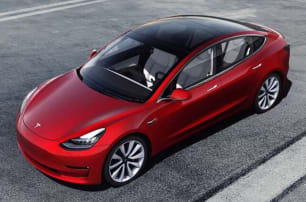Which Model 3 are we testing, you ask? Currently in Australia there are three options. The Standard Plus, Long Range Dual Motor, and the Performance.
Our car was the mid-grade Long Range Dual Motor. The dual-motor moniker just means it has the electric version of all-wheel drive, and Long Range indicates this is the one with the biggest battery, with an estimated range of 580km, according to the Worldwide Harmonised Light Vehicle Test Procedure (WLTP).
You'll note straight away this much range is unrivalled by pretty much any other EV on the market right now, but it comes at a cost.
This red car we tested wears a drive-away price of $93,549, with an MSRP of $86,325. Tesla provided a rather helpful breakdown of all the costs involved, making special mention of all the taxes you're slugged with if you buy one, specifically in NSW.
$7224 of on-road costs or not, the MSRP is still a far-cry from the affordable accessible electric car I bet Tesla wanted the Model 3 to be. To be fair here, you can get into the rear-wheel drive Standard Plus from an MSRP of $66,900 (or a smidge over $70k on-road, 430km WLTP range) which can bring the cost down a little.
It's a significant price-leap from non-premium competitors like the MG ZS EV ($43,990) and the Nissan Leaf ($49,990), though neither can come anywhere close to the Model 3's stellar range capacity.
A more reasonable direct rival, then, is the Hyundai Kona EV (from $60,740) which is competitive on range, too (449km WLTP).
The Long Range as tested here has 19-inch alloy wheels, 12-way power adjustable front seats, with heated seats all-round, clad in vegan leather, premium 14-speaker stereo (actually great), that huge 15-inch tablet floating in the centre which serves as both the multimedia interface and instrument cluster, full LED exterior lighting, a panoramic glass roof, heated auto-folding wing-mirrors, and a surround camera suite.
The safety stuff in this car is... unconventional, but we'll get to that in the Safety section of this review, and Tesla backs that huge screen with sim connectivity which it needs for various key features like the excellent phone app and built-in streaming services.
A very welcome dual wireless phone charging pad appears under the screen, which helps keep its slick interior wire-free.
The car also has more than its share of gimmicks which deserve a mention, like theatre mode, and being able to draw doodles on the screen and play mobile games while the car is parked and what not.
Wholly unnecessary, but if you've got kids they'll love it, plus the theatre mode is handy if you often spend time waiting behind the wheel.
Interestingly, the Model 3 has no CarPlay connectivity with the brand betting you'll use built-in versions of popular streaming apps.
You can also pre-set the nav using the Tesla app, but I found it a bit annoying being unable to browse my iPhone's music library easily, even though it can stream audio and calls via Bluetooth.






